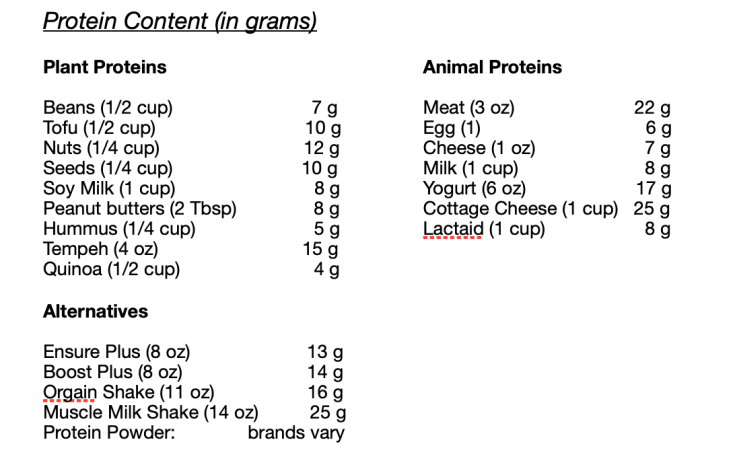Generally we eat plenty of protein in the US and we often hear that we need more. Even when I was a vegetarian, this was the most common comment people would make—that I probably wasn’t getting enough protein. But we know that’s not true as most vegetarians and vegans get plenty of protein. Blanket advice stating that everyone needs more protein is often misleading and shouldn’t be one size fits all. However, often when undergoing cancer treatment protein needs do increase. This is especially true in those with decreased food intake due to taste changes, mouth sores, or nausea.
An inadequate intake of calories causes weight loss, which some of us may like (hello Caribbean cruise!), but it can result in our bodies using its protein stores for energy, instead of using protein for essential body functions. Without enough protein in our diets, it may take longer for our bodies to recover from illness and cancer treatments. So if we don’t get enough calories and protein during treatment, our bodies will use what we already have stored by breaking down our muscle. This can result in increased fatigue and weakness (it can be a vicious cycle of no energy to eat and further weight loss and further fatigue).
But why is protein so important for our bodies? It is essential for body maintenance, growth, and repair. It is found in almost all of our bodies cells and has many functions which include the formation and maintenance of muscles, connective tissues, enzymes, hormones, and red blood cells. It also helps to maintain the balance of our body fluids, helps to fight infections, and increase immunity. It even helps with transportation of our medications even.
Your protein needs can very depending on your cancer type, if you have any wounds, had surgery, radiation, or chemotherapy, your labs, weight, and activity level. Some cancer types can cause hyper metabolism and this can affect how your body will use carbohydrates, fats, and proteins. If you’re into numbers, most healthy people need about 0.8 grams of protein per kilogram (2.2 pounds in a kg) of body weight. But with a cancer diagnosis and going through active treatment you may need between 1-1.5 grams of protein per kilogram of body weight as a good rule of thumb. You always want to check with your registered dietitian or medical care team however. Every persons individual needs will vary.
Protein is made up of 20 amino acids (compounds that combine to form protein) and protein comes from both plant and animal sources. Animal proteins are considered complete proteins meaning they have all 20 amino acids. If you are focusing on a meat free diet then you will need to make sure you are eating a variety of plant based proteins to get all 20 of your amino acids. For example, beans and rice will make a complete protein, as when paired together they have all of the compounds to make up a complete protein. So it’s important to be familiar with foods high in protein and to include them with each meal or snack to meet your needs.

Protein rich foods:
Meats: beef, chicken, fish, turkey, lamb, and pork, chicken salad, tuna salad, etc.
Dairy: milk, cheese, cottage cheese, cream cheese, yogurt, Kefir, or Lactaid (if lactose intolerant), milk shakes, pudding, cream based soups
Milk alternatives: soy milk (Of note, milk alternatives largely vary in protein content so it’s important to read the food label. Most are low in protein like almond or rice milk for example).
Eggs
Nuts and seeds: quinoa, almonds, cashews, sunflower seeds, macadamia nuts, flax seeds, pistachios, pumpkin seeds, trail mix etc.
Nut butters: almond butter, peanut butter, cashew butter, etc.
Legumes: edamame, hummus, tempeh, tofu, beans (but not green beans—good for you, but low in protein), peas, lentils
Additional options: protein powders, powdered milk, nutrition supplement drinks (like Ensure, Boost, Orgain, Glucerna, Carnation Instant Breakfast, Muscle Milk, etc.)
Ideas for how to incorporate protein sources into our meals and snacks:
- Add cream and/or protein powders to mashed potatoes, casseroles, soups, ice cream, hot cereals (cream or milk instead of water) and to the batter of pancakes, muffins, or baked goods.
- Add cheese to baked potatoes, casseroles, chili, omelets, tortillias, vegetables, soups, sauces or make a grilled cheese sandwich, or snack on string cheese. Eat sliced cheese with fruit like sliced apples for example.
- Add peanut butter to toast, crackers, smoothies, ice cream, oatmeal, sandwiches, waffles, or pancakes. Use as a dip for raw veggies, sliced apples, or on a banana.
- Add eggs to salads, casseroles, quiches, custards, or snack on a hard boiled egg.
- Add nuts to salads, casseroles, breads, muffins, pancakes, cereal, oatmeal, yogurt, or even ice cream.

The combinations are endless for adding protein to your diet. Try a few of these tips or see what you can come up with on your own that works for your lifestyle and see if you notice an improvement in your energy. As mentioned before, always check with your medical care team to see how much protein per day is appropriate for you, because everyone is different. Including some protein with each meal and snack is part of a well balanced diet however. There are many foods and nutrition supplements on the market, so ask your dietitian what might be best for if you want to try them. Recommendations depend on food allergies, taste, and your personal protein needs. Happy eating!
For more updates, you can follow Survivors’ Table on Facebook. Thanks for joining me on this journey! – Danielle



Thanks for the update.
LikeLike